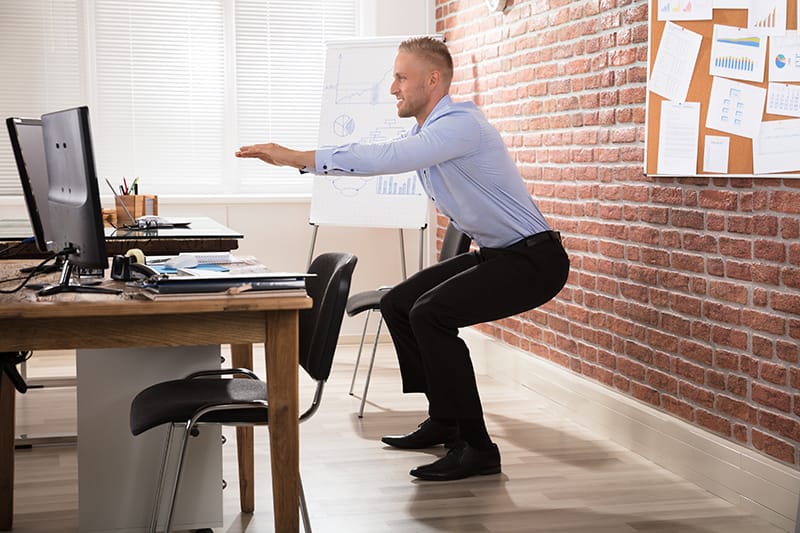Alright, look. I’ve been in the industrial mechanics field for a long while. Yeah, it’s a far cry from yoga, but hey, it taught me the value of a strong core and good posture. It’s like the chassis of a car: essential and often overlooked. Believe it or not, a strong core isn’t just for those looking to get ripped or show off at the beach. Nope. A strong core supports our back, promotes good posture, and can even help alleviate back pain.
Speaking of back pain, if you’re struggling with it, Tonya Fines has put together a comprehensive system called Unlock Your Spine to help people just like you. But, let’s get back to building that core while you’re stuck at your desk, shall we?
1. Seated Leg Lifts
Procedure:
- Sit on your chair, keep your back straight.
- Extend one leg out straight in front of you.
- Hold for a moment and then raise it as high as possible.
- Hold for a few seconds, then lower back down.
Benefits: Strengthens lower abdominals.
2. Chair Plank
Procedure:
- Place both hands on the arms of your chair, shoulder-width apart.
- Push your chair back until your body is extended and only your toes touch the floor.
- Engage your core and hold.
Benefits: Strengthens core and arm muscles.
3. Seated Oblique Twist
Procedure:
- Sit up straight with your feet flat on the floor.
- Put your hands behind your head.
- Turn your torso to the right and then to the left to complete one rep.
Benefits: Targets oblique muscles.
Now, we can’t always be at our desks, right? Sometimes, we travel. And while travelling, maintaining that posture becomes a nightmare. Remember, a bad posture can sneak up on you when you’re focused on exploring a new city or hustling to your next meeting. If you’re a frequent traveler, check out how to maintain good posture when traveling – it’s packed with essential tips.
4. Seated Bicycle Crunches
Procedure:
- Sit tall, hands behind your head.
- Bring your right elbow and left knee towards each other.
- Switch to the left elbow and right knee.
Benefits: Works on the rectus abdominis and obliques.
5. Chair Swivels
Procedure:
- Sit tall in a swivel chair, legs lifted slightly off the ground.
- Use your core to swivel the chair from side to side.
Benefits: Works on the obliques and helps in rotation flexibility.
It’s surprising, but certain fashion choices can also impact our posture. If you’re a fan of high heels, make sure you know how to wear high heels without compromising posture. Because while they look fabulous, they can really mess with your spine if you’re not careful.
6. Seated Marching
Procedure:
- Sit at the edge of your chair, back straight.
- March each leg up and down in a slow and controlled manner.
Benefits: Engages the lower abs and strengthens hip flexors.
7. Desk Push-ups
Procedure:
- Stand a couple of feet from your desk.
- Put your hands on the edge of the desk, shoulder-width apart.
- Lower yourself down towards the desk and then push back up.
Benefits: Works on your upper body and core.
Building core strength is crucial, not just for industrial mechanics, but for anyone who spends long hours at a desk. And it’s simpler than you might think. Incorporate these exercises into your daily routine and, combined with proper attention to posture, you might just save yourself from future back troubles. Cheers to a stronger, pain-free you!
The Importance of Core Strength
While the term “core strength” might be widely associated with the world of fitness and bodybuilding, it’s fundamental for everybody, no matter the age or physical condition. The core is the body’s central link that connects the upper and lower body. When it’s weak or inflexible, everything else underperforms. Be it the simple act of bending over to tie a shoe or performing a heavy-weight deadlift, the necessary motions either originate from the core or move through it.
Effects of Sedentary Lifestyle on Core Health
Living in a digital age, most of our tasks have been shifted to screens, requiring long hours of sitting. Prolonged periods of sitting can cause the core muscles to weaken, as they’re not actively engaged. Over time, this lack of engagement leads to poor posture, back issues, and even digestive problems. By integrating even a few minutes of core exercises into our daily routine, we can keep our muscles active, engaged, and strong.
Mind-Body Connection through Core Workouts
One often overlooked advantage of working on core strength is the strengthening of the mind-body connection. Core exercises, especially those requiring balance and stability, force one to focus on the movements, fostering a deep connection between the mind and the muscles being worked. This connection not only enhances physical performance but also promotes mindfulness, grounding, and being present in the moment.




